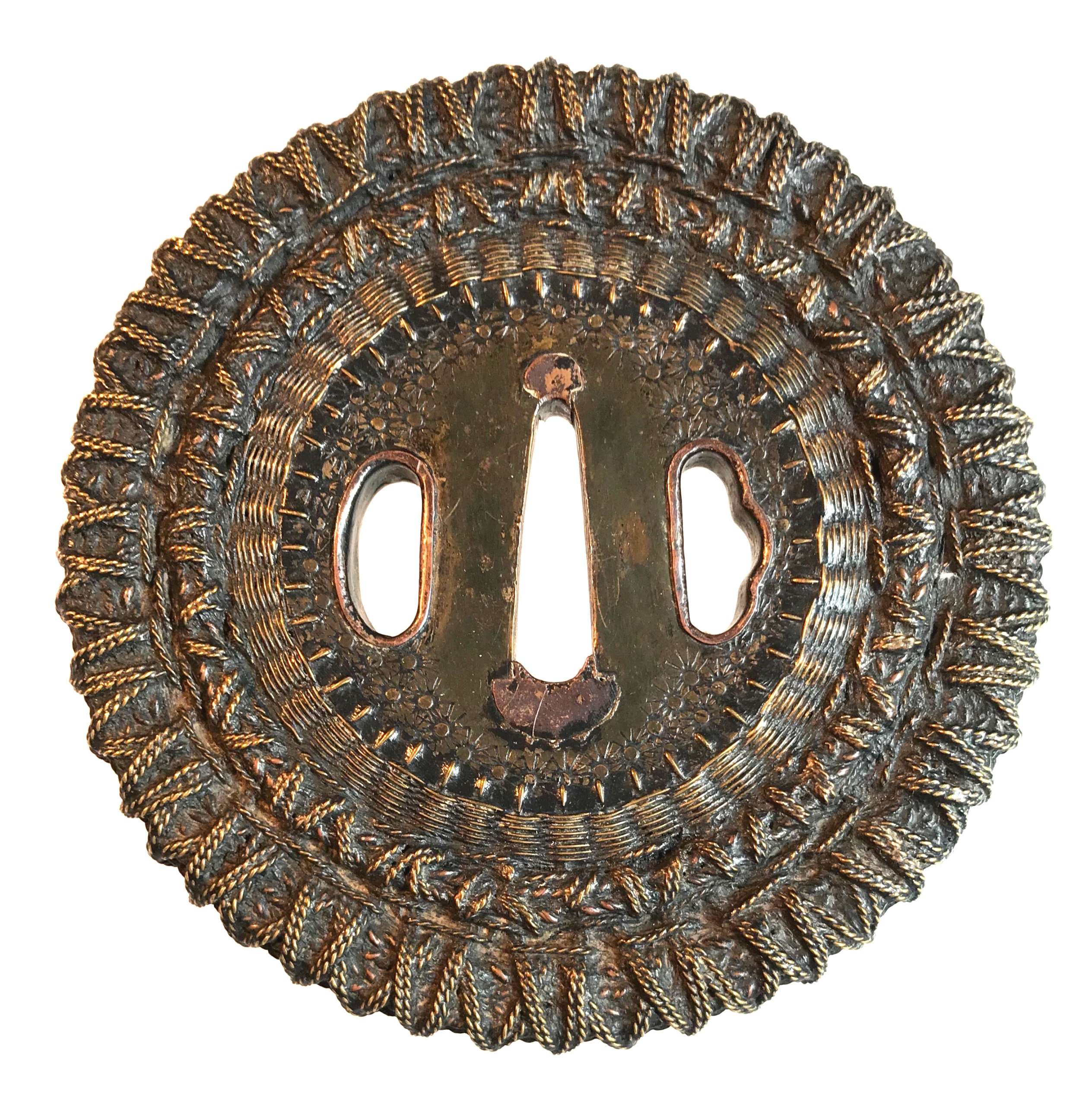After reading various sources describing the origins, types and forms of so-called Shingen tsuba, I decided to compile a sort of primitive bibliography on the topic. An important benefit provided by the blog format is that the author can edit the content ‘on a go’, i.e. as soon as a new source becomes available. I am not going to express my own judgment regarding the matter, just read, copy, scan, photograph, and provide references. It’s a compilation of bookmarks rather than a scientific (if study of art is a science) article. My interest to the topic is not random: within past 2-3 years I acquired several tsuba, which were sold to me under the title of “Shingen”; it is now the time to achieve some clarity regarding what I have purchased.
The earliest account regarding Shingen tsuba was found at “Japanese swords guards” by Okabe-Kakuya, published by Museum of Fine Arts, Boston in 1908[1]. The drawing presented at page 21 of the edition in no way matches what we today consider a “Shingen tsuba”, as the reader may easily see:
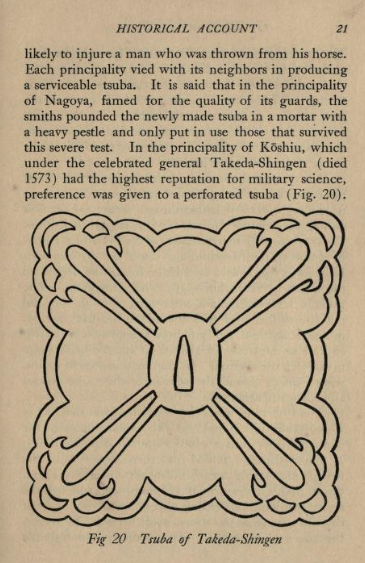
It is, though, possible, that this metal construction is the core of what then becomes a brass wire woven tsuba. To find out whether my guess is correct, I would need to disassemble a fine piece (oh no!) or to X-ray it (I am planning to talk to my dentist).
Books are said to be made of books, and two years later the same design surfaced in the paper of Comte de Tressan[22] across the Pond:
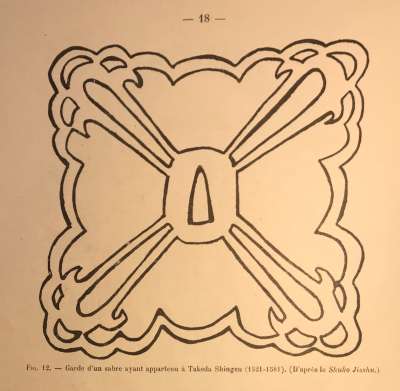
Bulletin de la Société Franco-Japonaise de Paris, juin-septembre 1910, №19-20 plus un volume intitulé Planches pour accompagner l’article de M. Charles Leroux sur la musique japonaise. Incl.: Comte de Tressan: L’évolution de la garde de sabre japonaise de la fin du XVe siècle au commencement du XVIIe (suite),
As the Okabe-Kakuya’s text states, “In the principality of Kōshiu, which under celebrated general Takeda-Shingen (died 1573) has the highest reputation for military science, preference was given to a perforated tsuba (Fig. 20)”. “The principality of Kōshiu” here most probably stands for Kōshū (甲州市 Kōshū-shi) — a city in Yamanashi Prefecture, where the said “Takeda-Shingen” was buried. In Section II “Schools of Tsuba Makers” there is a sub-section “Mukade tsuba” with the following text: “The “mukade” design originated from a representation of a mukade or centipede, but soon became conventionalized out of all recognition. Sometimes the tsuba were twisted coils of metal bound together with wire, sometimes merely inlaid with different metals to give that appearance. Some writers give the date of its origin as the sixteenth century, but all we can be certain of is that it did not come into fashion until the early part of the eighteenth. The centipede is an insect sacred to Bishamon, the god of war.” From this description we see that Okabe-Kakuya referred the tsuba “merely inlaid with different metals to give that appearance” and “tsuba were twisted coils of metal bound together with wire” to the same class, which he called “mukade“, but put “Takeda-Shingen” tsuba, as he understood it, to a different section of his taxonomy. This is Okabe-Kakuya’s mukade tsuba (№ 280):

The fist description of Shingen tsuba, as we know it, can be found at “Japanese sword-mounts in the collection of Field Museum” by Helen C. Gunsaulus, published in 1923[2]. It presents two black and white photographs:

followed by description:
“An unusual group of tsuba popular in the late sixteenth century and afterwards is made up of those guards known as Shingen tsuba, a name which was derived from a sixteenth-century warrior, Takeda Shingen (Takeda Harunobu, 1521-73), who is said to have preferred this style of guard, as it combined strength and lightness. Under the category of “Shingen”, four different types are generally listed, though a fifth appears in the drawings in the Boston Catalogue of Okabe Kakuya “Japanese Sword Guards” (p. 21). It is square, that form which is said to have been used in Ashikaga days for scaling walls, the sword having been set up as a step. […] The following descriptions include, however, the Shingen tsuba usually met with.
-
So-called Mukade (“centipede”) tsuba are made of iron in which a centipede is inlaid in brass or copper wire. Mukade tsuba of Myōchin and Umetada workmanship have been found with the inscription, “Made to the taste of Takeda Shingen”.
-
There are those of solid iron, with neat centers of brass, to the edges of which is affixed a weaving of brass and copper wires which is bound to the foundation disk by a rim, usually decorated simply.
-
Another type is of solid iron, bored at intervals and laced with braided or twisted wires of copper and brass.
-
The fourth type is a chrysanthemoid form, chiseled in open work and laced or woven tightly with copper and brass wire.”
In 1948, someone Donald McCormack of the Riggs National Bank consigned the collection of Alexander G. Moslé to the Parker-Bernet Galleries of New York[3]. In the first part of this sale, lot 99 mentions Shingen tsuba: ‘Two Shingen tsuba with bamboo weave designs, one in sentoku”[4]. [Sentoku is brown colored copper-lead-zinc alloy]. In the second sale, lot 20 includes “two shingen tsuba, partly gilded”[5]. None of the catalogues presents an image of the said pieces.
In 1975, the highlights of Peabody collection have been published with an example of Shingen tsuba (fig. 1, page VI): “Iron, mokko shape. Centipede-like inlay (mukade zogan) of alternating iron and brass staples produce an appearance that was particularly favored by Takeda Shingen (1521-1573), one of the most powerful warlords of his time. The centipede is sacred to Bishamon (God of War) and especially propitious for a warrior. Shingen type, 16th century.”[6]

Much later, in 2010 Robert E. Haynes provided high quality color images, which meet the description provided 87 years earlier. Haynes examples include three species:
- Page 115.

“Iron plate with slight mokkō form with delicate raised rim. The wide edge area inlaid with brass rinzu pattern, repeated on the reverse. The web of the plate is a many spoke wheel form that has now been woven with copper wire and overlaid with a copper rope that is bound with brass wire. This is repeated on the reverse. The woven wire is not original to the rest of this tsuba., but was added later, sometime in the Edo period. This addition of brass wire is to be seen in many tsuba that are now called Shingen tsuba. The Shingen name is taken from the great daimyō Takeda Shingen Harunobu (1521-1573) who it is said favored this style of tsuba. Unfortunately, there is not a shred of proof to this stody. The origina; plate of this tsuba was made by the Saotome family school and is a rather early example of the work of that school. The brass inlay is unusual for the Saotome school, but not unheard of. There are a number of styles od the Shingen and mukade style of tsuba but most are just time consuming workmanship rather than great art”.
- Page 116:

“Iron mokkō form plate with iron, brass, and shakudo wire inlay near the rim area. This is repeated on the reverse side. This type of tsuba is referred to as mukade tsuba. Mukade means centipede and refers to the many legs of the insect. There does not seem to be a signed example recorded, and if there were it would probably be for the plate alone”.
- Page 117:

“Brass outer plate of round shape. This tsuba has an iron core tsuba of spoke form as made by Saotome school, ca. 1500. There are brass plates on either side connected to the rim by woven brass and shakudō wire. The wire has been hand drawn, which is very difficult. The hitsuana are brass lined and the rim has a brass cover. This type of tsuba is referred to as a Shingen tsuba. This is a reference to Takeda Shingen Harunobu (1521-1573), the great and famous daimyō. Why this name has been applied to this type of tsuba is unknown, though the theory is that he favored this style of tsuba, but that seems apocryphal at best. It is more likely that it was made by an artist who worked in brass and made such a piece as a tour de force.”[7]
Further, in 2016, Gary D. Murtha dedicates a full page 67 of his self-published book “Japanese Sword Guards. Onin-Heianjo-Yoshiro” to mukade tsuba, though he remarks: “although not considered Heianjo tsuba, the mukada tsuba illustrated on this page show the effect of Heianjo-zogan had on other tsuba styles. This passage is followed by a story, cited from Nihonto Daihyakka Jiten, regarding why and how Takeda army employed the symbol of centipede on its banners (hata-jirushi and nobori) as well as sword mountings. He concludes, that “it is possible that mukade tsuba were being made as early as late Muromachi although most, like these two, are from Edo period.”[8]

Other mentions mentions of Shingen tsuba are numerous and include sources from a popular Japanese sword blog ‘Nihonto Message Board” to Museum of Fine Arts in Boston to Ashmolean Museum of Oxford.
Ricecracker.com: http://www.ricecracker.com/inventory/983_tsuba_shingen/983_tsuba_shingen.html
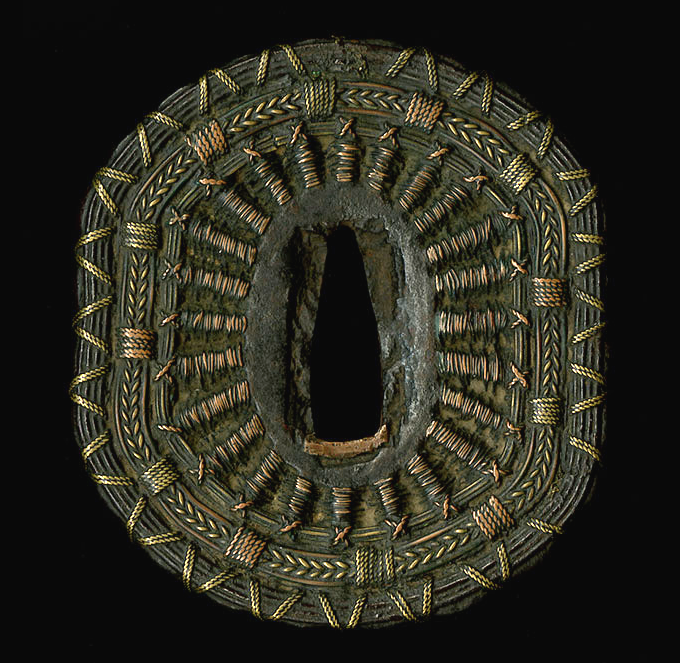
“Very interesting tsuba known as a “Shingen” (信玄) tsuba. There are a few examples of this type of tsuba that supposedly originated from the Famous warlord Takeda Shingen. One story is that Takeda Shingen wrapped brass wire around a iron sukashi tsuba while waiting patiently before a major battle. Supposedly this kept him calm and focused and able to react and think in a clear manner when it counted. Because of this practice of his, many of his supporters followed in his actions and made these tsuba as well. Apparently, this habit carried on through the Edo period, as there are examples made during the 1600’s -1700’s. Basically, these type of tsuba are a large iron sukashi plate with brass wire wrapped in and out of the design. There is alot of time and effort put into the weaving of these tsubas design, and the few examples that are left are very interesting for collectors. A few strands are missing, but in otherwise good condition and excellent patina on the iron. Also comes with a tsuba box with 信玄鐔 “Shingen Tsuba” written on it.”
MFA, Boston (1): Tsuba with woven wire pattern. Edo period, 18th century, Shingen School, DIMENSIONS: 8.6 x 8.5 x 0.4 cm, ACCESSION NUMBER: 13.2159, Main material: brass; decorative technique: woven wire and punching. Provenance: Purchased from Chikami Kiyoomi, former governor of Kagoshima, by Okakura Kakuzo.

MFA, Boston (2): Tsuba with woven wire pattern. Edo period, 18th century (?), Shingen School, DIMENSIONS: 8.5 x 8.5 x 1 cm, ACCESSION NUMBER:11.5436, Main material: iron; other metals: brass and copper; decorative technique: woven wire. Provenance: 1890, Charles Goddard Weld Collection; bequest to MFA, Boston, December 7, 1911.

MFA, Boston (3): Tsuba with woven wire pattern. Edo period, 18th century (?), Shingen School, DIMENSIONS: 7.1 x 6.3 x 0.7 cm, ACCESSION NUMBER: 11.11958, Main material: iron; other metals: brass and copper; decorative technique: woven wire. Provenance: By 1911, purchased by William Sturgis Bigelow (b. 1850 – d. 1926), Boston [see note 1]; 1911, gift of Bigelow to the MFA. (Accession Date: August 3, 1911).

MFA, Boston (4): Tsuba with woven wire pattern. Edo period 18th–19th century, Shingen School, DIMENSIONS: 8.5 x 8.5 x 0.4 cm, ACCESSION NUMBER: 13.2157, Main material: iron; other metals: brass and copper; lead plug; decorative technique: woven wire. Provenance: Purchased from Chikami Kiyoomi, former governor of Kagoshima, by Okakura Kakuzo

Ashmolean Museum of Art and Archeology, University of Oxford, and particularly by The A. H. Church Collection of Japanese Sword-Guards (Tsuba) provides an interesting insight:
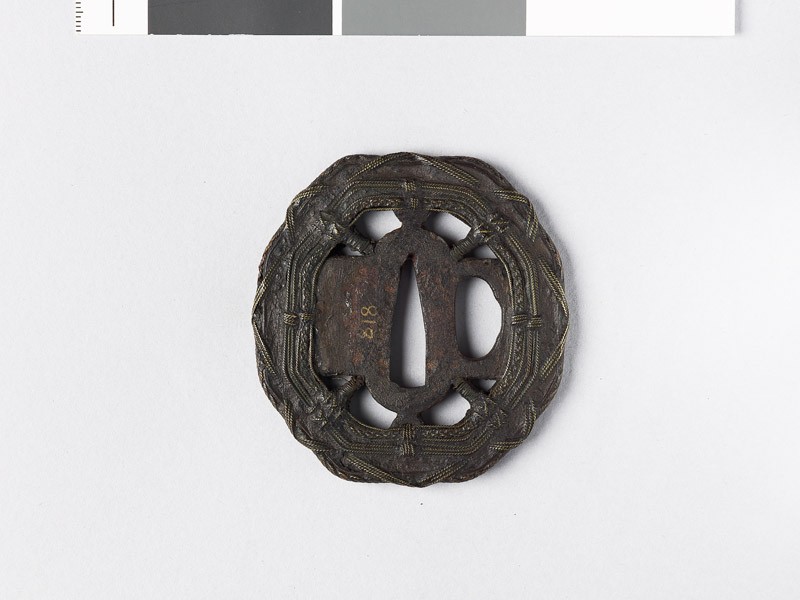
EAX.10180. Octagonal tsuba with radiating decoration
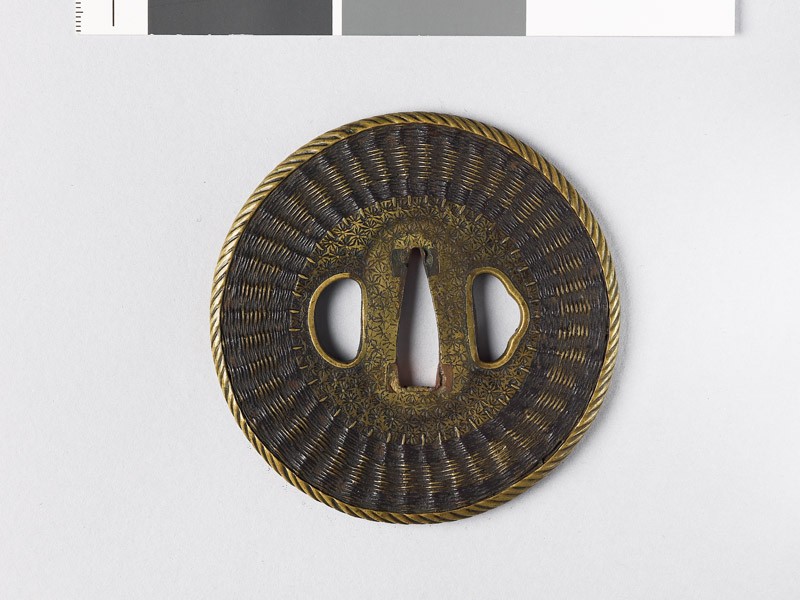
EAX.10181. Tsuba with basketwork decoration.
The description of Shingen tsuba at Ashmolean:
“The term “Shingen” is given to two peculiar forms of decoration consisting of brass, iron or copper wires more or less loosey applied to the iron forming the ground or core of the guard (not fixed by brazing as with Gomoku work). The name is sometimes extended to the Mukade work dealt with in the last Group.
In one form, which may be called the Wire-bundle Type, the guard is overlaid with symmetrically disposed bundles of wires, single or stranded, which are lashed down by other wires threaded through holes pierced through the guard. Sometimes the actual body of the guard is completely covered by the wiring and often a guard of Akasaka type with geometrical openwork is used for the purpose.
In another form, the Mat-weaving Type, a frank imitation of the woven mats used as kettle-stands at the Tea Ceremony is laid over either face of the circular iron plate, a brass rim holding all in place.
Shingen Guards are supposed to date from the time of Takeda Shingen, the great territorial lord (about 1560), who is said to have encouraged their manufacture; but they did not become generally fashionable until the 18th century.”
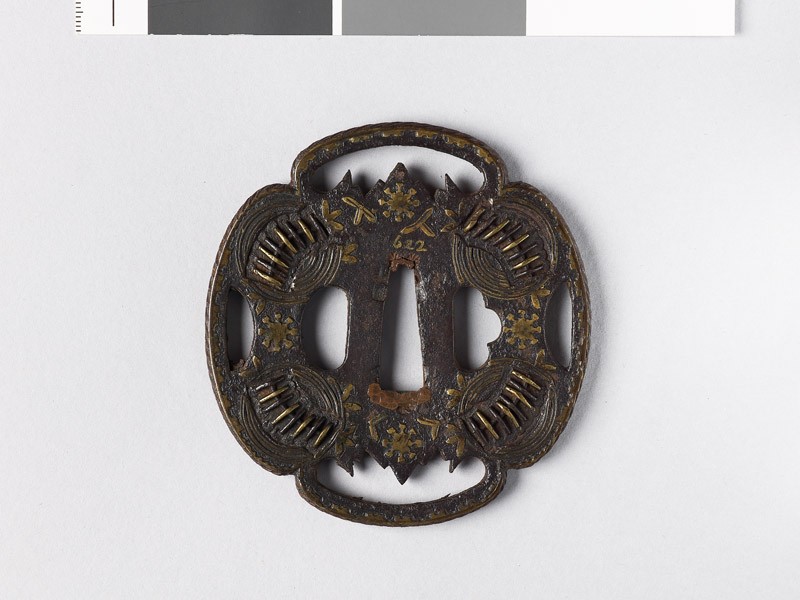
EAX.10179
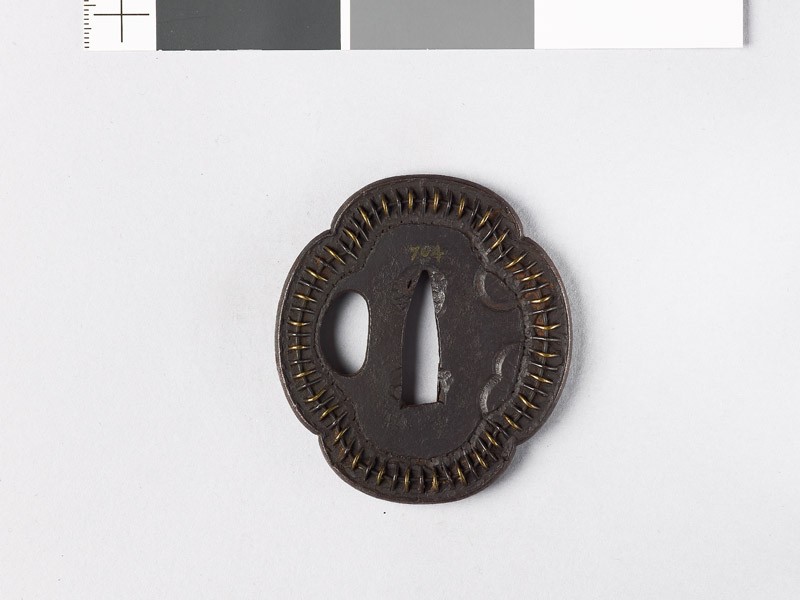
EAX.10178
At the end, I just want to mention that Encyclopedia of Japanese Swords By Markus Sesko[9] provides the following definition of Shingen school:
“Shingen-tsuba – Iron tsuba with brass wires wrapped in a weaving manner in and out of sukashi openings. It is said that once the famous warlord Takeda Shingen (1521-1573) started to wrap brass wires around his sukashi-tsuba to keep him calm whilst waiting for the start of a battle. It is also said that some of his retainers copied him and that this was how such tsuba became fashionable. Later on, similar tsuba was made which were not woven but with brass just inlayed to resemble a woven pattern. Such tsuba are sometimes also referred to as mukade-tsuba as their ‘fake’ woven design running along the rim reminds of a centipede (mukade).”

In Wikimedia, there is one mention of Shingen school of tsuba, with no details provided: File:Shingen type sword guard (tsuba), 17th century Japan, brass and copper.
A few more examples of Shingen tsuba can be found in available reference sources.
An unusual case is presented at Plate CLIV under №1167 at Henri L. Joly and Kumasaku Tomita book “Japanese art and handicraft”[10].
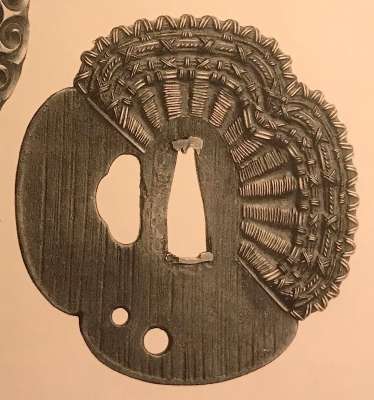
Three shingen tsuba in “Japanese Sword Fittings. A descriptive catalogue of the Collection of G.H. Naunton, Esq.”, Plate XXVII [11].

645. – Iron, circular, chased with wood grain rim and three rats in relief, the namako [sea cucumber] shaped spaces fitted with Mukadé wire work.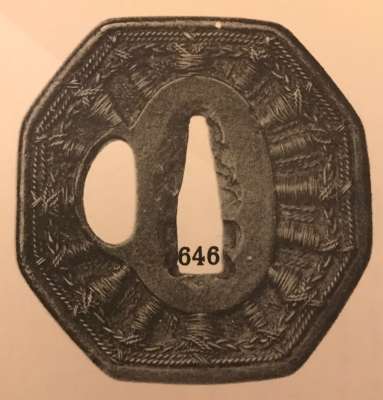
646. – Octagonal, covered with brass wire and copper rope, the basis an old sixteen-ray tsuba.

647. – Shingen, mat pattern, entirely woven in brass. Ex Hawkshaw Collection. XVIII.
That’s the description, provided by Henri L. Joly on page 51:
There are four types of Shingen tsuba: –
(a) Solid iron inlaid with a centipede of iron, copper and brass wire, called Mukade.
(b) Perforated iron, old tsuba usually of chrysanthemoïd design covered with copper or brass wire, of which in the early Nineteenth Century specimens were made weighing up to a pound.
(c) Solid iron covered with a pattern of braided copper and brass wire.
(d) Mat pattern usually with iron centre.
The name generally adopted for the last three types is that of Takeda Shingen who is said to have had a fancy for that work. The tsuba illustrated as having been his property do not quite support that statement, but tsuba with the centipede design (Mukadé) emblematic of the God of War are found in Miochin and Umetada work, described as being “To the taste of Takeda Shingen”. It may be that confusion occurred and that all Mukadé and wire woven tsuba became lumped indiscriminately under the same name.
Catalogue of Naunton Collection was initially published in 1912 and re-printed in 1973.
At “The Hartman Collection of Japanese Metalwork”[12], on page 69 we see another specimen of Shingen (№ 242): Circular iron, a mukade (centipede) design in brass and iron wire – 8 cm, unsigned, 19th century.

At Collection of Alfred J. Cohn, Sotheby Parke Bernet Inc., 1981[13], one Shingen tsuba is listed under № 58: “Very good mukade tsuba, 17th Century, unsigned, Diameter: 9.2 cm”:
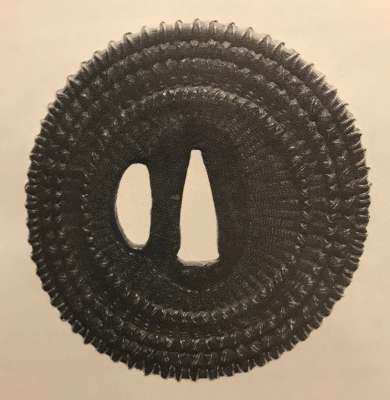
From the Collection of Dr. Walter Ames Compton (Part I), 1992[14], at page 40-41, item 91: “A Shingen style tsuba, Edo period (circa 1750). The oval iron plate has a wide rim and is carved with a running wave pattern. It has twenty-four spokes which are now wrapped in brass wire on the rim and with copper wire over the spokes height 8.5 cm, width 8 cm, thikness at center 5 mm, at edge 9.25 mm. The palte of this tsuba is the work of the Saotome school, whose characteristic marks appear around the nakago-ana, The age of the plate is either Momoyama or early Edo (circa 1573-1650). It appears to have been bound subsequently with the wire in the mid-Edo period in a style traditionally said to have beeb favored by Takeda Shingen (1521-1573).
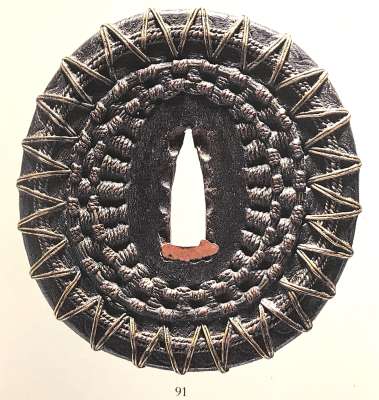
Robert E. Haynes. Catalog #1. San Francisco, November 13-15, 1981[15]: 168 — Very good later Shingen tsuba, ca. 1700; Diameter 78 mm, thickness at center 3.5 mm. Similar to the one in Field Museum collection (№2).
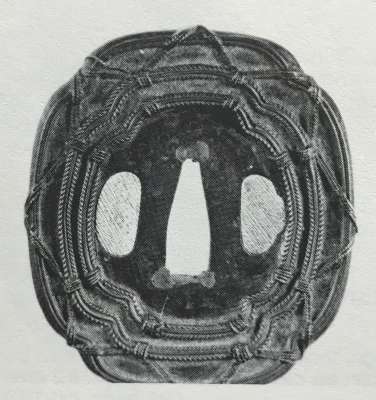
Robert E. Haynes. Catalog #4. San Francisco, November 1-28, 1982[16]: №1094 – Large Mukade style example. The thick plate is covered with a heavy combined brass rim area and the classic style mukade of both iron and alternating brass over a center iron wire. This would seem to be a very early example of this style. 86 mm (H) x 3.5 mm (Th/center), 5 mm (Th/edge).
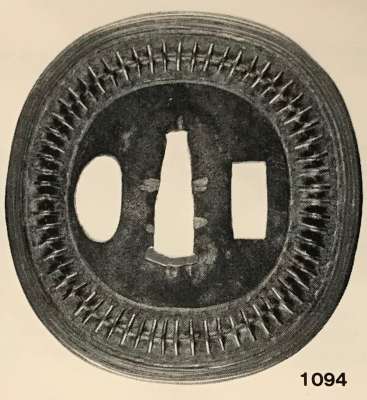
Robert E. Haynes. Catalog #5. San Francisco, March 1-27, 1983[17]: №46 – Good classic mukade inlay style example, ca. 1700.
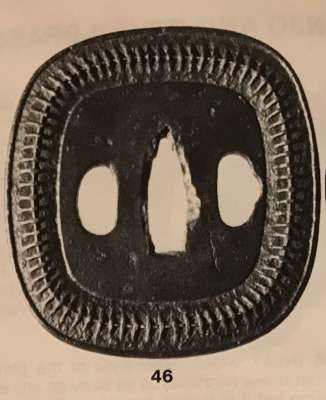
Robert E. Haynes. Catalog #7. San Francisco, September 1-25, 1983 : №№ 156, 157 and 158[18]:

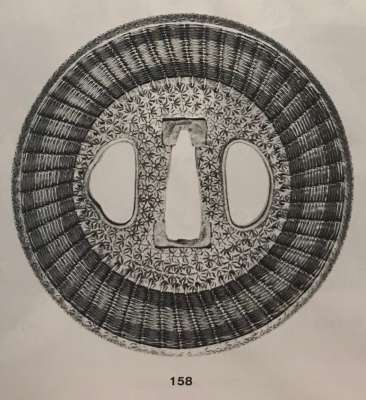
In here Robert E. Haynes delivers his verdict:
156 – Exceptionally large “Shingen” style tsuba. Classic wheel shape Saotome tsuba. The name is taken from Takeda Shingen. It is said that he favored this style of tsuba. “Unfortunately there is no proof of this and we can find no evidence that he ever wore such a tsuba on any of his swords. It would seem that by mid Edo period there were many old Saotome wheel tsuba around.Since they were no longer in fashion, why not use them for a new style that could be sold. In the long winters of the north, one could not do the amount of work one wanted and there was time to wrap such a tsuba. All it took was patience.It could be done by any worker or even his wife”. This example is as large as ever found. Diameter 10.4 cm, thickness at center 6.5 mm, at the edge 12.5 mm.
157 – A classic size and style of Shingen tsuba. Plate age ca. 1600, wire age ca. 1750. Diameter 9.4 cm, thickness at center 4.75 mm, at the edge 10.5 mm.
158 – Classic alternative style of Shingen tsuba. In thei case, the center core up to the edge of the hitsuana is iron. The center sheets of brass are held in place by the woven brass and shakudo mesh of the web of the plate. The rim is brass as well, and has the same star punch kokuin stamp as the center. If Takeda Shingen did use a Shingen tsuba, this style is probably what would have been found on his sword, but even this style has not given us any proof. Also not one is old enough to date from the days of Takeda Shingen. From Alexander G. Mosle collection, vol. I, p. 176, № 465, Plate XL. Diameter 8.8 cm, thickness at center 5.5 mm, at the edge 4.5 mm.
Robert E. Haynes. Catalog #8. San Francisco, May 8-12 and May 21-27, 1984[19]: № 329 – Typical classic Mukade tsuba. Iron plate, alternating wires are brass, iron and copper. The edge in brass. Ca. 1750. Diameter 85 mm, thickness 4.5 mm.

Robert E. Haynes. Catalog #9. San Francisco, May 8-12 and May 21-27, 1984[20]: Classic early Mukade style tsuba. Alternating brass and iron wires. Ca. 1700. Diameter 77 mm, thickness 3.5 mm.
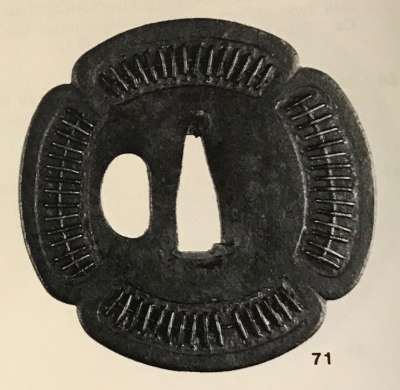
Japanese Works of Art, Part II. Sotheby’s, London, November 17, 1994[21]:
№ 393 — Mukade tsuba, Momoyama to Edo period (late late 16th-17th century). Typical design of gilt and iron wire. Above two udenuki-ana.
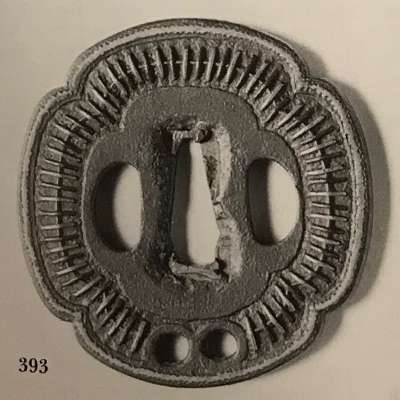
№ 524 — An unusually large Shingen tsuba. Early Edo period (early 17th century). Design of ropes and basketwork in silver, brass and copper wire. Diameter: 11.5 cm. Ex Henri Vever collection. [Substantially over R. E. Haynes’ “This example is as large as ever found. Diameter 10.4 cm, thickness at center 6.5 mm, at the edge 12.5 mm”, see above].
№ 525 — An iron Shingen tsuba. Early Edo period (early 17th century). The thick plate typically applied with an arrangement of brass ropes in great detail. Diameter: 95 mm.

And one more piece, a reproduction of the specimen from Comte de Tressan collection[22], described as a “Mukade” type and attributed to the second half of XVIth century; no mention of Takeda Shingen whatsoever:

February 4, 2018. Update.
Quite a few Shingen tsuba were found at W. L. Behrens Collection by Henri L. Joly:
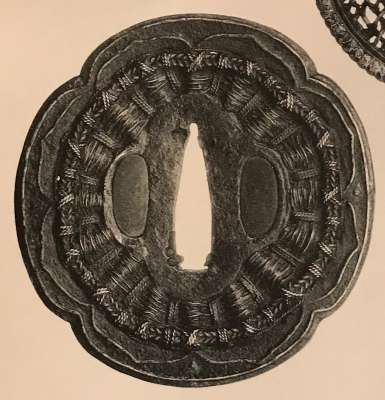
W. L. Behrens Collection, №1609: Iron, mokko, with wire cusps and the whole centre covered with wire. Ex-Garié collection (988). Plate XXIV.

W. L. Behrens Collection, № 1603, 1601, 1605, 1606, 1607, 1590, 1597. Plate XXVII. Mukade. Shingen.
Conclusion.
The origins of Mukade design remains unclear. Some speculate that it is a simplified or somewhat abstract representation of the brass woven tsuba. However, for practical purposes and to make sure that people speak about the same thing, I would not mix the terms, and keep Mukade tsuba and brass wire woven tsuba (or Shingen Proper) as distinct taxonomical divisions. It seems possible that design (TSU-0234) was the earliest (late Muromachi period), design (TSU-0289) was a later development of the same concept in Momoyama period, and design (TSU-0388), nicely looking massive piece of 290 g, represents purely decorative tsuba of Edo period. The development of Mukade design might have walked a totally different path, though possibly started from the same starting point.

TSU-0234: Height: 72.5 mm; Width: 69.8 mm; Thickness at seppa-dai: 4.0 mm; Weight 88.8 g.

TSU-0298: Height: 88.4 mm; Width: 86.6 mm; Thickness at seppa-dai: 4.6 mm; Weight: 132.4 g.

TSU-0338: Height: 98.0 mm; Width: 97.4 mm; Thickness at seppa-dai: 6.0 mm; Weight: 290 g.
[1] Japanese sword guards by Okabe-Kakuya, in cooperation with the Department of Chinese and Japanese art; Museum of Fine Arts, Boston, 1908.
[2] Japanese sword-mounts in the collection of Field Museum by Helen C. Gunsaulus, Assistant Curator of Japanese Ethnology. 61 plates. Berthold Laufer, Curator of Anthropology. Field Museum of Natural History, Publication 216, Anthropological Series, Volume XVI; Chicago, 1923; p. 45; pl. VII, 1 & 2.
[3] Japanese Sword Fittings from the Alexander G. Moslé Collection; Sebastian Izzard LLC, 2004.
[4] Japanese Art. Part one of the collection of of Alexander G. Moslé, Washington, D.C. by direction of Donald A. McCormack, Committee, Assistant Vice-President, The Riggs National Bank of Washington, D.C. Public auction sale April 22 at 2 pm, Parke-Bernet Galleries, Inc., New York, 1948.
[5] Near and far eastern art from the collections of Alexander G. Mosle, the late Mrs. Henry I Riker and other sources. Public auction sale May 12 & 13 at 2 pm, Parke-Bernet Galleries, Inc., New York, 1948.
[6] The Peabody Museum collection of Japanese sword guards with selected pieces of sword furniture, by John D. Hamilton. Photographs by Mark Sexton. Salem, MA, 1975.
[7] Robert E. Haynes. Study collection of Japanese sword fittings. Nihon Art Publishers, 2010; p. 115-117.
[8] Gary D. Murtha. Japanese Sword Guards. Onin-Heianjo-Yoshiro. GDM Publications, 2016; p. 67.
[9] Encyclopedia of Japanese Swords by Markus Sesko, Published by Lulu.com, United States, 2014.
[10] Henri L. Joly and Kumasaku Tomita. Japanese art and handicraft. An illustrated record of the loan exhibition held in aid of the British Red Cross in October – November, 1915. London, Yamanaka & Co, 1916.
[11] Japanese Sword Fittings. A descriptive catalogue of the Collection of G.H. Naunton, Esq., completed and illustrated by Henri L. Joly.// The Holland Press, London, -1973.
[12] The Hartman Collection of Japanese Metalwork / which will be sold at auction by Christie, Manson & Woods Ltd. June 30 and July 1, London, 1976.
[13] Important Japanese Swords, Fittings, and Armour, Including the Collection of Alfred J. Cohn, Richmond, Virginia, and a series of important blades and fittings including An Highly Important Dated Tachi by Shodai Tadayoshi, An Extremely Rare Daito by Founder of the Bungo School, Bungo Sadahide (Jōshu). Catalogue for May 5, 1981; Sale 4596Y). // Sotheby Parke Bernet Inc.
[14] Japanese Swords and Sword Fittings from the Collection of Dr. Walter Ames Compton (Part I). Specialists in charge: Sebastian Izzard and Yoshinori Munemura. Christie’s, New York, March 31, 1992.
[15] Robert E. Haynes, Ltd. Highly important Japanese swords and kodogu. San Francisco, November 13-15, 1981.
[16] Catalog #4. Robert E. Haynes, Ltd. Important Japanese tsuba, early iron and kindo examples. San Francisco, November 1-28, 1982.
[17] Catalog #5. Robert E. Haynes, Ltd. Fine Japanese tsuba, fittings, woodblock prints, netsuke, inro and books on swords and tsuba. San Francisco, March 1-27, 1983.
[18] Catalog #7. Robert E. Haynes, Ltd. Masterpiece tsuba and kodogu from the Hans Conried and Alexander G. Mosle collections. Important woodblock prints by Utamaro, Hokusai, Hiroshige, Yoshida and other masters. San Francisco, September 1-25, 1983.
[19] Catalog #8. Robert E. Haynes, Ltd. Important signed Shoami tsuba. Collection of menuki, kozuka, and fuchi-kashira. Interesting and important 19th and 20th century woodblock prints and books. San Francisco, January 16 – February 12, 1984.
[20] Catalog #9. Robert E. Haynes, Ltd. Masterpiece and highly important tsuba, menuki, and fuchi-kashira from eminent collections in America, England, France, and Japan. San Francisco, May 8-12 and May 21-27, 1984.
[21] Japanese Works of Art, Part II: Swords and Fittings, Netsuke and Lacquer. Sale LN4670 “SUZUKI”. Sotheby’s, London on November 17, 1994.
[22] Comte de Tressan: L’évolution de la garde de sabre japonaise de la fin du XVe siècle au commencement du XVIIe. Bulletin de la Société Franco-Japonaise de Paris, Juin-Septembre 1910, №19-20, pp.7-35.
[23] W. L. Behrens Collection, Part III. Tsuba. Catalogue by Henri L. Joly. Fascicule II. London, Glendining & Co., LTD. 1913-1914. Printed to One Hundred Copied only of which this is Number 58.


